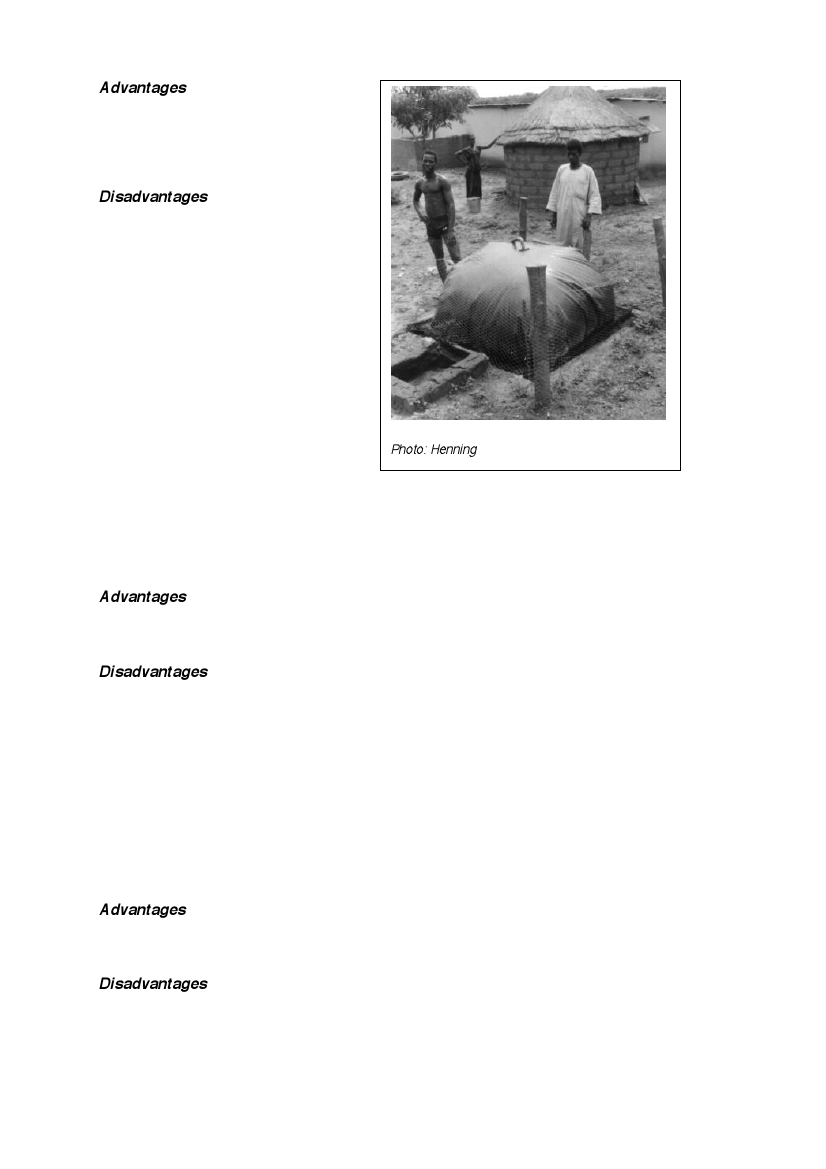
Advantages are low cost, ease of
transportation, low construction
sophistication, high digester
temperatures,
uncomplicated
cleaning,
emptying
and
maintenance.
Disadvantages can be the
relatively short life span, high
susceptibility to damage, little
creation of local employment and,
therefore, limited self-help
potential.
A variation of the balloon plant is
the channel-type digester, which
is usually covered with plastic
sheeting and a sunshade (Figure
4E). Balloon plants can be
recommended wherever the
balloon skin is not likely to be
damaged and where the
temperature is even and high.
Figure 5: Small "foil-plant" (Ivory Coast)
Photo: Henning
Fixed-dome plants
The fixed-dome plant consists of a digester with a fixed, non-movable gas holder, which sits
on top of the digester. When gas production starts, the slurry is displaced into the
compensation tank. Gas pressure increases with the volume of gas stored and the height
difference between the slurry level in the digester and the slurry level in the compensation
tank.
Advantages are the relatively low construction costs, the absence of moving parts and
rusting steel parts. If well constructed, fixed dome plants have a long life span. The
underground construction saves space and protects the digester from temperature changes.
The construction provides opportunities for skilled local employment.
Disadvantages are mainly the frequent problems with the gas-tightness of the brickwork gas
holder (a small crack in the upper brickwork can cause heavy losses of biogas). Fixed-dome
plants are, therefore, recommended only where construction can be supervised by
experienced biogas technicians. The gas pressure fluctuates substantially depending on the
volume of the stored gas. Even though the underground construction buffers temperature
extremes, digester temperatures are generally low.
Floating-drum plants
Floating-drum plants consist of an underground digester and a moving gas-holder. The gas-
holder floats either directly on the fermentation slurry or in a water jacket of its own. The gas
is collected in the gas drum, which rises or moves down, according to the amount of gas
stored. The gas drum is prevented from tilting by a guiding frame. If the drum floats in a
water jacket, it cannot get stuck, even in substrate with high solid content.
Advantages are the simple, easily understood operation - the volume of stored gas is
directly visible. The gas pressure is constant, determined by the weight of the gas holder.
The construction is relatively easy, construction mistakes do not lead to major problems in
operation and gas yield.
Disadvantages are high material costs of the steel drum, the susceptibility of steel parts to
corrosion. Because of this, floating drum plants have a shorter life span than fixed-dome
plants and regular maintenance costs for the painting of the drum.
To contrast these simple biogas plants, Figure 6 gives an impression about dimensions of
industrial plants which are, for example, built in Europe.
17